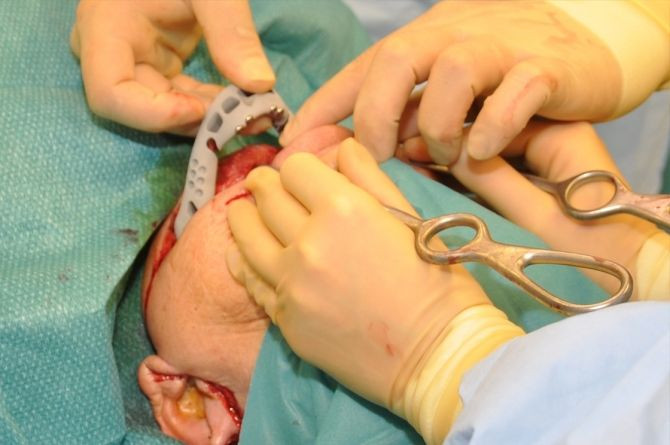3-D Printer-Created Jaw Implanted in 83-Year-Old Woman

A group of medical researchers from Belgium and the Netherlands successfully replaced the jaw of an 83-year-old woman with a 3-D printer-created lower jaw in what doctors say was the first operation of its kind.
The transplant operation conducted in the Netherlands in June was meant to treat the woman’s osteomyelitis, a severe bone infection that affected her entire lower jawbone, but details of the groundbreaking procedure have just emerged.
The customized 3D-printed lower jaw was made out of titanium powder that was heated and fused together through a process known as laser melting. This method uses a high-powered laser that bound together the powdered metal layer by layer, and was coated with bio-ceramics that made the bone-substitute compatible with the body tissue.
Doctors had determined that the woman’s jaw had to be replaced, but because of her age and other factors, traditional reconstructive surgery would be too dangerous, so instead researchers had worked with an implant company Xilloc and decided to instead replace her entire mandible with a 3-D printed model.
The researchers said after the lower jaw implant was designed it only took a few hours to print.
A surgical operation attached the 3-D printed implant to the woman’s skull, and doctors said that after just a day following her surgery, the woman could speak and swallow normally, and had full operation of her mouth after all the surgery incisions healed. She went home four days later.
The surgical team said that the operation to attach the implant to the woman’s face only took four hours, a fifth of the time required for reconstructive surgery.
"Shortly after waking up from the anesthetics the patient spoke a few words, and the day after the patient was able to swallow again," said Dr Jules Poukens from Hasselt University, who led the surgical team in a statement released on Sunday.
"The new treatment is a world premiere because it concerns the first patient-specific implant in replacement of the entire lower jaw," Poukens added.
Engineers said that the operation’s success prepares the way for the use of more 3-D printed patient-specific parts.
Post operative X-ray of the patient with the full mandibular implant.
The research was done at the Biomedical Research Institute at Hasselt University in Belgium, and the implant was built by LayerWise, a Belgium-based manufacturer that specializes in metal-parts.
The new jaw weighs 3.774 ounces, less than a quarter of a pound which was about a third heavier than before, and the doctors said that the woman would have no problem getting used to the extra weight.
The woman’s follow-up surgery is scheduled to be performed later in February when the team will take out healing implants that had been inserted into the holes in the jaw to provide a set of dentures.
The research also followed a separate project in Washington State University in 2012 when engineers demonstrated how a 3-D-printer-created ceramic scaffold could be used to promote growth of new bone tissue.
Researchers said animal experiments suggested that the technique could be used in humans within the next 20 years.
LayerWise calls the process Additive Manufacturing, and hoped that their technique could be in the future applied to a variety of medical fields such as dentistry, orthopedics, maxillofacial and spinal surgery because it has proved to limit surgical complications.
“As illustrated by the lower jaw reconstruction, patient-specific implants can potentially be applied on a much wider scale than transplantation of human bone structures and soft tissues,” said Dr. Peter Mercelis, Managing Director of LayerWise in a statement.
“The use of such implants yield excellent form and function, speeds up surgery and patient recovery, and reduces the risk for medical complications,” Mercelis concluded.
Video: LayerWise builds world's first complete lower jaw implant
The 3D printed implant with the artificial bone coating. The rims for the mandibular nerves and the condylar heads are highly polished. Fixture sites for future prosthetic superstructures are visible.



























